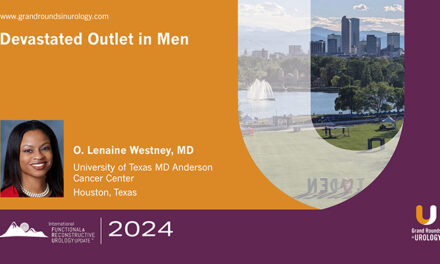Thomas Hope, MD, presented “Appropriate Use of PSMA PET in Clinical Practice” during the 32nd Annual International Prostate Cancer Update (IPCU32) conference on March 8, 2022, in Snowbird, Utah.
How to cite: Hope, Thomas. “Appropriate Use of PSMA PET in Clinical Practice” March 8, 2022. Accessed May 2025. https://grandroundsinurology.com/appropriate-use-of-psma-pet-in-clinical-practice-thomas-hope/
Appropriate Use of PSMA PET in Clinical Practice – Summary
Thomas Hope, MD, Assistant Professor in Abdominal Imaging and Nuclear Medicine in the Department of Radiology at the University of California, San Francisco, discusses the appropriate use of PSMA PET (prostate-specific membrane antigen PET scan) in clinical practice under the Protecting Access to Medicare Act (PAMA). Dr. Hope begins by introducing PAMA, a 2014 act that establishes a program for the “appropriate use” of diagnostic imaging services. He then introduces the appropriate use criteria (AUC) for PSMA PET imaging as introduced by the Society of Nuclear Medicine and Molecular Imaging (SNMMI). Dr. Hope explains that the AUC committee developed 11 clinical indications on a scale from 1-9, where 7-9 is appropriate, 4-6 may be appropriate, and 1-3 is rarely appropriate. He notes PAMA guidelines consider a score of less than six inappropriate, and therefore Medicare does not support it. Dr. Hope addresses scoring in the three categories of the AUC: initial staging indications, biochemical recurrence indications, and castration-resistant prostate cancer (CRPC). Dr. Hope outlines the studies that inform these guidelines. An UCLA/UCSF and an OSPREY study indicate remarkable similarity in sensitivity (40% and 40%) and specificity (95% and 98%) for PSMA PET. In biochemical recurrence studies, the patient-level detection rates for stratified PSA were also similar (38% and 36%). A study on PSMA PET in nmCRPC showed 98% positive PSMA PET. Dr. Hope notes that the detection of nodal metastases positively correlates with lower uptake in the primary tumor. He also states that the PSMA UAC will be updated to include PSMA radioligand therapy (RLT) once 177Lu-PSMA-617 is approved. To finish, Dr. Hope discusses the similarities between National Comprehensive Cancer Network (NCCN) guidelines and the SNMMI AUC. He notes that both agree conventional imaging is not necessary before PSMA PET.
About the 32nd Annual International Prostate Cancer Update (IPCU32):
Presented by Program Chair E. David Crawford, MD, The International Prostate Cancer Update (IPCU), is a multi-day, CME-accredited conference focused on new developments in prostate cancer treatment, diagnosis, and prevention. IPCU 32 featured lectures, interactive discussions, panel roundtables, debates, and case reports. This conference was led by expert physicians and is designed for urologists, medical oncologists, radiation oncologists, and other healthcare professionals involved in the diagnosis and treatment of prostate cancer.
ABOUT THE AUTHOR
Thomas Hope, MD, is an Assistant Professor in Abdominal Imaging and Nuclear Medicine in the Department of Radiology at the University of California, San Francisco. He received his MD from Stanford University and completed an internship at Kaiser Permanente, a residency in Diagnostic Radiology at UCSF, and a Clinical Fellowship in Body MRI and Nuclear Medicine at Stanford. He is the Director for Molecular Therapy. Dr. Hope is the PI on the Ga-68 PSMA-11 IND, has helped lead the development of the clinical PET/MRI program, and is developing the program for neuroendocrine tumors at UCSF. He has published 100+ peer-reviewed articles and is a member of the Radiological Society of North America, the Society of Nuclear Medicine and Molecular Imaging, and the International Society for Magnetic Resonance in Medicine.



